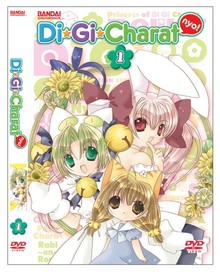Review
by Carl Kimlinger,Di Gi Charat Nyo
DVD 1 - Nyo Arrival
| Synopsis: |  |
||
Streaking from the sky in a flying saucer of suspect aesthetics comes an alien princess bent on dominating the planet, by becoming... an actress! Armed with eye beams, seven mysterious "princess tools" and an arsenal of frighteningly oversized hair accessories, it's Di Gi Charat (Chocolat to her mother, Dejiko to everyone else)! Sent to Earth by her mother to for "princess training" (but in actuality, sent away just to get her out of everyone's hair), Dejiko is accompanied by Gema, her pathetic yellow blob of a guardian, and Petit Charat (AKA Puchiko) a wise-beyond-her-years toddler friend. Together they face such daunting obstacles to their goals as: finding each other after they crash-land, moving in with the locals, losing a purse, a local celebrity/wannabe magical girl, and a bath-house owner who refuses to believe in them. Go girls! Don't give up! |
|||
| Review: | |||
After spending a period wading in a sea of undiluted cuteness while detailing Dejiko's innocent childhood in Panyo Panyo Di Gi Charat, the lazy, spiteful, cynical Dejiko of the original series returns for this full-length TV series. As fun as unabashed cuteness is, it's a welcome return to form, even if the new format is problematic. The original Digi Charat episodes were six minute bursts of bracingly mean-spirited fun featuring incongruously cute characters. The transition to half-hour episodes (albeit split into two 12-minute half-episodes) is a rocky one. The need to stretch the original's patented meaningless plots to twice the size results in a little more down time—during which Dejiko and company walk about while weird things wander willy-nilly throughout the frame—than is really good for the show's crucial laugh-quotient. The laughs themselves tend towards chuckles and "what the hell?" snickers, though there are a few real gut-busters (Dejiko's mother revealing her true reason for sending Dejiko away, the bath-house owner's blind insistence on skepticism despite constant evidence to the contrary) also scattered throughout. As before, the most consistent humor stems from the contrast between Dejiko's mercenary personality and butt-scratching manners, and her frilly-cute exterior, with some cruel jabs at magical girls thrown in for good measure. And also as before, one's enjoyment is heavily dependent on one's tolerance for non-stop weirdness and willingness to jettison unrealistic expectations about narrative niceties like plots and characters. The sooner you do so, the sooner you can get down to enjoying the silliness for silliness' sake. Whether in its plot or visuals, the series makes no attempt at anything even approaching realism. It takes place in a flat cartoon world, full of flat (often featureless) cartoon characters moving in flat cartoon ways. Settings are simplified (sometimes literally) to children's drawings. And while Dejiko and company's shopping arcade is a busy, colorful place, it's all intentionally cheap. There is a lot of surreal invention involved in the humor, all of which is intended to look as home-made as possible. In fact, the only solid evidence that Digi Charat has indeed entered the shiny digital age are the shiny digital character designs, which emphasize the elaborate costumes and cuteness of the three female leads (Dejiko, Puchiko and Rabi~en~Rose). Toshio Masuda is probably one of the best, and most underrated, of anime composers. Best because of his uncanny knack for composing catchy, memorable music that perfectly matches the tone of a series (Excel Saga's manic energy, Ai Yori Aoshi's gentle melancholy, Naruto's rocking action) without calling attention to itself. And underrated for the exact same reasons. The down side to this knack is that poorer shows tend to have poorer music. His compositions for this series are exactly the kind of minimalist, bouncy yet strange fluff that the series requires, and are as ultimately substanceless and ephemeral as the show itself. The opening—with its accompanying montage of bizarre, and bizarrely well-animated, images—is a shrill number from the show's lead actresses, while the end is a cover of CoCo's "Equal Romance" (a Ranma ½ ending tune) by Priere. If any of the time that this title spent in production limbo was spent on improving its dub, it doesn't show. Many questionable decisions were made in the casting of this series, starting with Gema's clogged-sinuses line delivery, including Puchiko and Kiyoshi's slightly-too-old voices, and ending with Dejiko's shrill, insistent performance. Of course, many of the performances are actually quite good, the translation of the series' riddles make sense in English while sticking as closely to the original riddles as possible, the English script is reasonably faithful overall, and John and Paul (two minor otaku characters) have British accents that make The Beatles' reference more explicit. But the dub overall has a slightly unnatural stage-(or recording booth)-bound feel to it that does nothing to alleviate the casting mistakes. Not a terrible dub by any stretch, but not very good either. Company previews and a clean ending are the only on-disc extras you can expect from this release. Now that Bandai has finally gotten around to releasing it, Digi Charat is back, and its the same silly, mean-spirited comedy that we know and love(?), just a little diluted and slowed by its newly expanded time frame. Exactly the thing to while away a couple of hours chuckling. |
| Grade: | |||
|
Overall (dub) : C+
Overall (sub) : B-
Story : B-
Animation : B
Art : B
Music : B
+ A return to the meaner, funnier spirit of the original series. |
|||
| Production Info: | ||
|
Full encyclopedia details about Release information about |
||